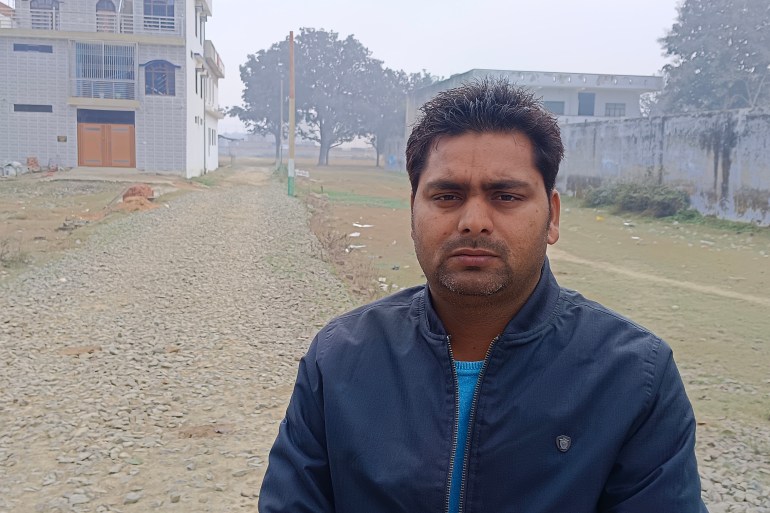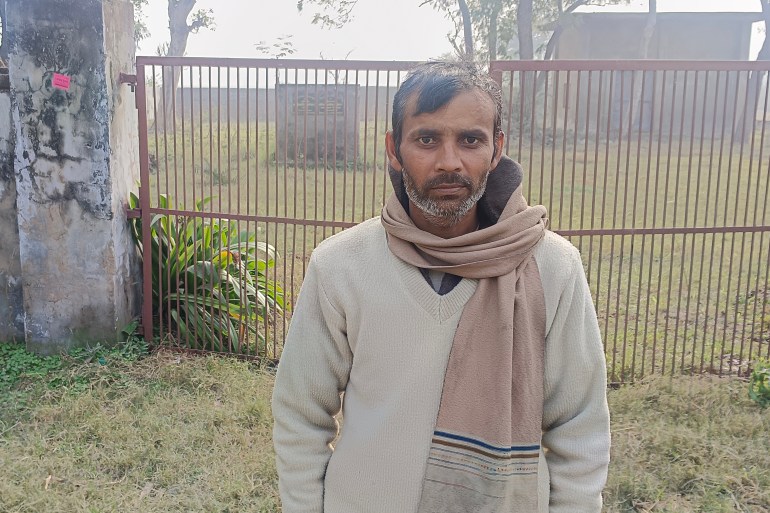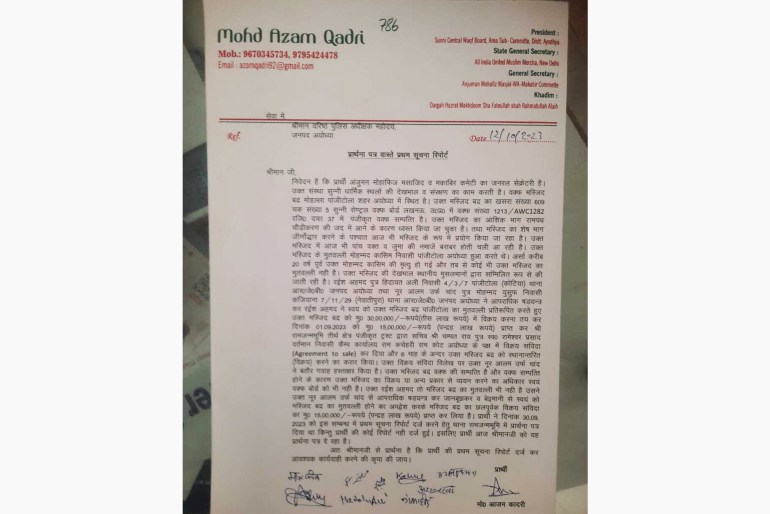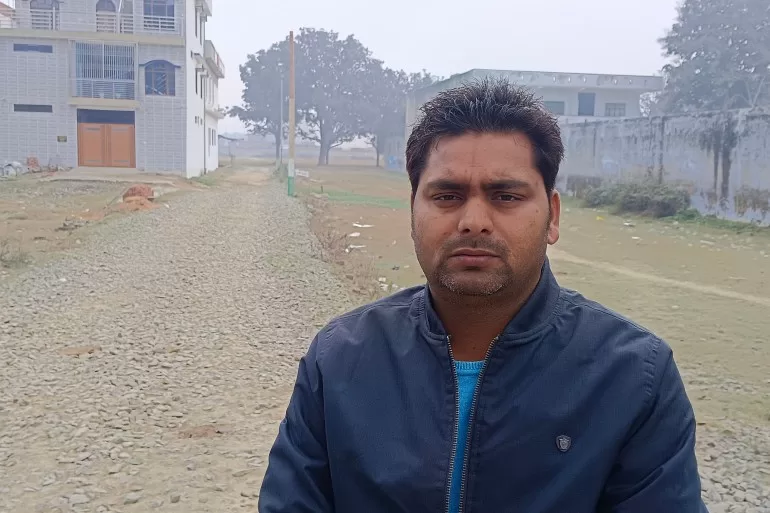A farmer in Takpura village in the Ayodhya district of the north Indian state of Uttar Pradesh, about 155km (96 miles) from Lucknow, the state capital, he received 25 million rupees ($300,000) when he sold his 1.55 acre (0.6 hectares) patch of land to a local property dealer four years ago.
The 65-year-old believes that he could have gotten at least 10 times that amount had he delayed his decision to now.
“Land is costlier than the gold here, with prices surging since the verdict for building a Ram temple was announced by the Supreme Court in 2019. I made the mistake of selling my land before the judgement. Had I delayed the land deal, it could have fetched me a far better price than what I had received then,” Verma told Al Jazeera.
Verma, whose land holding is 7km (4.3 miles) from the temple, is yet to decide on selling his remaining 4.65 acres (1.88 hectares) of land. “The property brokers and customers are making a beeline outside my house every day, offering me lucrative prices for the land but I will not repeat the same mistake again. A delay would certainly fetch me a higher price,” he said.
Verma is not alone in adopting a wait-and-watch policy on selling his land. Several thousand farmers and landholders in the Ayodhya district and its neighbouring areas are doing the same, expecting exponential prices for their land which is in massive demand mainly to build commercial properties there.
The boom in real estate began after India’s apex court in its verdict on November 9, 2019, ruled in favour of the construction of a temple to the Hindu god Ram at the 2.77-acre (1.12-hectare) disputed site in Ayodhya. The court also allocated a separate 5 acres (2 hectares) of land to Muslims near Ayodhya to build a mosque.
The verdict turbocharged the political and religious movement that for decades had been campaigning to build a temple at a spot that many Hindus believe was the birthplace of Ram. But it also opened new business avenues for entrepreneurs who began to tap investment opportunities in Ayodhya in anticipation of the millions of tourists expected to visit the temple after its inauguration on Monday, by Prime Minister Narendra Modi.
Vinay Kumar Verma, 33, a property dealer in Ayodhya, told Al Jazeera that his phone has not stopped ringing for the past six months, with people inquiring about the availability of land for building hotels.
“Earlier, I used to receive one to two calls every month asking for land for commercial use. But now I am getting eight to nine calls per day for this,” he said.
Some of those calls are from people in other states who are interested in building hotels and guest houses to cash in on the huge influx of pilgrims that are expected to visit the holy city, pushing up prices from 16 million rupees ($190,000) per acre of land in 2019 to about 64 million rupees ($770,000) now.
“And still, people are ready to pay more, expecting huge returns after investing in commercial properties like hotels and guest houses,” Verma said. “The land here is even costlier by four to five times than that in the state capital, Lucknow.”

The days leading up to the January 22 consecration of the temple have seen an explosion in demand for hotel rooms from visiting tourists and pilgrims – buttressing the business logic of real estate firms looking to build more hotels in Ayodhya.
Most hotels are booked out and have hiked up rates for rooms even when they are available after the temple launch.
Jitendra Pandey, 41, who has been a real estate agent in Ayodhya for the past 12 years, said he has never witnessed such an increase in land prices. “The prices of commercial property have increased by four to five times because of the deep pockets of buyers who are willing to pay any price for the land. Even the prices of residential property have gone up by 2.5 times. The commercial rates are high because outsiders are not interested to settle here but want to make much of the business opportunity,” he told Al Jazeera.
Farmers, he said, are the main beneficiaries because they are not only getting exorbitant prices for the land but some buyers are also connecting directly with them in order to avoid real estate agents commissions.
Real-estate majors have jumped in too. Mumbai-based House of Abhinandan Lodha (HOABL) has acquired 25 acres (10 hectares) of land and plans to invest 12 billion rupees ($1.4m) in Ayodhya to develop a seven-star mixed-use enclave that would host luxurious facilities for buyers including a swimming pool, gym and banquet halls, among other amenities.
Bollywood superstar Amitabh Bachchan has booked a piece of land of about 10,000sq feet (929sq metres) in this upcoming project for 145 million rupees ($17.43m), according to local media reports.
HOABL did not respond to Al Jazeera’s request for information about the new project.
The city is also witnessing a wave of modernising with star hotels like the Park Inn by the Radisson Group, as well as malls and showrooms of multinational companies that have set up their outlets in recent weeks, including Tata Group’s high-end jewellery store Tanishq which opened its showroom in the city in December.
A new township
Realising the potential of Ayodhya on its way to becoming the spiritual hub for millions of Hindus globally, the state government has since 2020 acquired 1,407 acres (569 hectares) of land to build Navya Ayodhya, or the new township of Ayodhya, on the outskirts of the city.
Om Prakash Pandey, an executive engineer with the Uttar Pradesh Housing and Development Board, told Al Jazeera that the total township would be spread across 1,857 acres (751.5 hectares) of land for which another 450 acres (182 hectares) would soon be acquired from farmers.
“It would be an eco-friendly township with all modern facilities and both residential and commercial complexes,” he said.
The state government, he added, had bought the land from 1,200 farmers for which it paid 67.6 million rupees ($814,000) for 2.47 acres (1 hectare) of land. That, he said, was four times the circle rate or the minimum base price of property set by the state government.
The state has allocated land within that to the states of Uttarakhand and Gujarat, both run by the BJP, to build guest houses in the township, Pandey told Al Jazeera.
“The entire township will be built at a cost of 65 billion rupees ($78.23m) and likely to be completed by 2032 and the first phase is likely to be ready by 2028 at an investment of 21.8 billion rupees ($26.22m),” he said.

Despite the government’s claims of offering four times the base price of the land, farmers are still not happy with it.
Jhapsi Yadav, 40, a farmer and a resident of Kallupurwa village, whose land falls in the proposed township area, told Al Jazeera that the private buyers are willing to pay far more than the government rate.
“The private buyers are ready to buy land at six to seven times the circle price of the state government and even more if the land is close to the highway. But we have no option but to sell off the land to the state government that has been chosen for the township. We are dejected but can do nothing about it.”
The astronomical rise in the prices of the land has even bewildered the officials of the Shri Ram Janmabhoomi Teerth Kshetra Trust, which is in charge of the construction of the Ram temple. “It is really unthinkable that prices have gone so high in such a short period.
The local farmers should be cautious in land deals and should only dispose of the land when they get good prices for it. But the investment would definitely help people in generating livelihood locally,” said Sharad Sharma, the media officer in charge of the trust.
Allegations of encroachment

But the skyrocketing in the prices of land has also led to allegations of encroachments by the Muslim community.
Md Azam Qadri, the sub-committee president (Ayodhya) of the Sunni Central Waqf board, said more than 200 properties belonging to the Waqf board, including cemeteries, mosques and idgahs (places of public prayer) have already been encroached on by the land mafia – realtors who have moved into the area in the past decade – for commercial purposes, mainly for the building of guest houses and hotels.
“There were minor cases of encroachment in our properties, mainly cemeteries and Idgahs since 1992 when the Babri mosque was demolished in Ayodhya. But the encroachments have increased in the past five years since the verdict of the Supreme Court that allowed the construction of the temple over the disputed land … mostly by outsiders trying to establish their business here.”
Qadri said he had written to senior district officials, Chief Minister Yogi Adityanath and Prime Minister Modi, complaining about the issue and seeking their intervention but no action has been taken yet. “The chief minister had promised strict action against land grabbers but the officials have done nothing in this matter.”
Vishal Singh, the vice-chairman of Ayodhya Development Authority (ADA), said he had not received any complaints on the matter.
